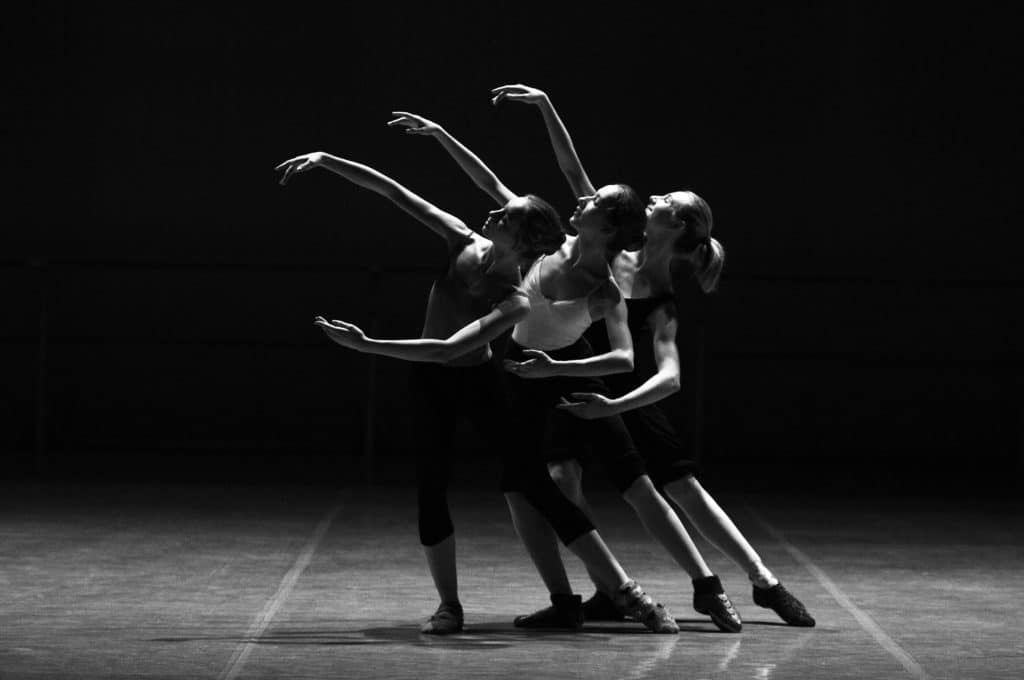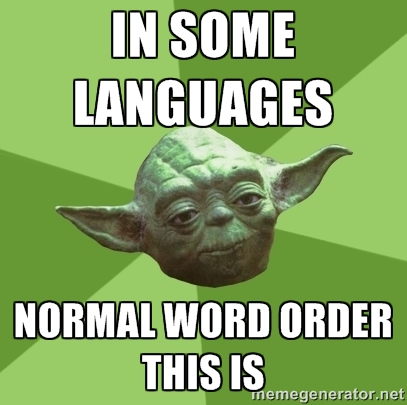Russian grammar —> Word order in Russian
In English, the word order plays an important role because it shows the relationships between parts in the sentence (subject, object, etc.). For example, if we say «Cats eat mice», we clearly understand that «cats» is here the subject of the action «eat» and the object of this action is «mice». If we switch the position of nouns «cats» and «mice», we get «Mice eat cats», a sentence with a different meaning. So, in English sentence the grammatical sense depends on word order.
However, Russian word order is very flexible. The relationships between parts of the Russian sentence are shown by the endings of words. Depending on the grammatical sense and role in the sentence, Russian words have different endings.
Look at the following example:
Кошки едят мышей. — Cats eat mice.
In the Russian sentence, the object of the action is shown by the ending -ей of the word мышей. That is why, if you change the position of the Russian words, the overall meaning of the sentence will not change. You can say:
Кошки едят мышей.
Мышей едят кошки.
Едят кошки мышей.
Едят мышей кошки.
In these sentences, the subject and the object of the action «eat» remain the same.
So, because of words endings, the parts of the Russian sentence can go in almost any order without causing any misunderstanding on the part of the listener.
If you want to know more about word endings and their grammatical role in Russian, we recommend you to see the page Cases in Russian on our website.
For the beginner in Russian there is nothing very important to remember about word order – other than the fact that it is very flexible. For example, while translating a Russian sentence, you can use the word order of the English sentence and native speakers will always understand you.
At the same time, Russian word order has its own peculiarities. One of these peculiarities is that in written Russian new information (or emphasized information) comes at the end of the sentence. For example, look at the sentence:
Мария едет в Москву. — Maria goes to Moscow.
The emphasis is on the word Москва (Moscow), it is a new information because this sentence tells where Maria goes. If another word order is used:
В Москву едет Мария. – It is Maria who goes to Moscow.
The emphasis is on the word Мария (Maria), and, in this case, the sentence tells who goes to Moscow.
In a conversation, the word order is more flexible since intonation and stress may be used to show the emphasized information in a sentence.
Have you ever had difficulties with combining Russian words? We’re sure you know what we’re talking about. Russian word order is important because it makes sentences make sense. Without understanding the main principles of combining words, you won’t be able to communicate with native speakers while, let’s say, vacationing in Russia over the holidays or chatting on social media.Russian sentence structure is one of the most significant parts of learning the grammar rules of this language. If you learn how to make sentences word by word now, you probably won’t have problems with more difficult themes in the future. So let’s start studying!
Table of Contents
- Overview of Word Order in Russian
- Basic Word Order with Subject, Verb, and Object
- Word Order with Prepositional Phrases
- Word Order with Modifiers
- How to Change Your Sentence into a Yes-or-No Question
- Translation Exercises
- Conclusion
1. Overview of Word Order in Russian
The Russian language word order is SVO, but the existing grammar rules allow us to change it. So, sometimes, the typical SVO Russian word order can become VSO. That’s why we can say that word order in Russian sentences is quite flexible.
So, does word order matter in Russian? When comparing word order in English and Russian, we can notice one big difference. Russian word order doesn’t matter grammatically as much as English word order does.
Before having Russian sentence structure practice, you should definitely learn the most popular Russian phrases and words. It’s impossible to make sentences without knowing them by heart.
If you’re an advanced speaker, you may read Russian books and learn new words from them.
2. Basic Word Order with Subject, Verb, and Object
According to the basic Russian word order, you must start your sentence with the subject. Then comes the verb, followed by the object. If you use this word order in Russian sentences, you’ll never make a mistake. For example:
- Я читаю книгу. (Ya chitayu knigu.) — “I read a book.”
There are also some cases when you can use VSO instead of SVO. It’s appropriate if the sentence contains two verbs, and you want to emphasize the first one. It sounds good if you’re telling a story. For example:
- Читаю я книгу и вдруг… (Chitayu ya knigu i vdrug…) — “I’m reading a book, and suddenly…”
Be careful with VSO in Russian, though. It may sound really weird if you use it while making an order in a restaurant, talking to a stewardess during your flight to Russia, in an emergency, or in other formal situations.
3. Word Order with Prepositional Phrases
Prepositional phrases answer the following questions:
- Where?
- When?
- In what way?
Prepositional phrases that answer the question “Where?” are typically used at the end of the sentence, after the object:
- Я читаю книгу дома. (Ya chitayu knigu doma.) — “I read a book at home.”
In Russian sentence structure, prepositional phrases that answer the question “When?” are put either at the very beginning or at the end of a sentence. The meaning of the phrase will change a bit, though. For example:
- Сегодня я читаю книгу. (Segodnya ya chitayu knigu.) — “Today, I read a book.”
- In this case, this sentence answers the question “What did I do today?”
- Я читаю книгу сегодня. (Ya chitayu knigu segodnya.) — “I read a book today.”
- This one answers the question “When did I read a book?”
Prepositional phrases that answer the question “In what way?” can be used right after the noun or at the end, after the verb. Both variants are grammatically correct, but the first one sounds more natural:
- Я увлеченно читаю книгу. (Ya uvlechyonno chitayu knigu.) — “I enthusiastically read a book.”
- Я читаю книгу увлеченно. (Ya chitayu knigu uvlechyonno.) — “I read a book enthusiastically.”
When there are two (or even more) prepositional phrases, you should use them in the following order:
- Put the prepositional phrase of time in the first place, before the noun.
- Add the prepositional phrase that answers the question “In what way?“ after the noun.
- Use the prepositional phrase of place after the object, at the end.
Here’s an example:
- Сегодня я увлеченно читаю книгу дома. (Segodnya ya uvlechyonno chitayu knigu doma.) — “Today, I enthusiastically read a book at home.”
If you don’t want to learn all these rules about building sentences in Russian, you may always put the prepositional phrase at the end of the sentence. Of course, doing so is appropriate only for beginners. Advanced students must know and use more complex rules regarding sentence structure in Russian.
4. Word Order with Modifiers
In most cases, the modifier is an adjective which describes something. In Russian word order, adjectives are always used before nouns:
- Я читаю интересную книгу. (Ya chitayu interesnuyu knigu.) — “I read an interesting book.”
If there are two or more adjectives in the sentence, you should:
- Firstly, use the one which expresses your own opinion about the subject or marks something about the subject that’s not very stable.
- Use the adjective which denotes a very stable aspect as close to the noun as possible.
For example:
- Я читаю интересную научную книгу. (Ya chitayu interesnuyu nauchnuyu knigu.) — “I read an interesting scientific book.”
Note that Russian sentence structure with adjectives is more or less flexible. There are no actual Russian word order rules that say you must use one type of adjective before another (e.g. shape before color). Try not to think too hard about how to order words in Russian when it comes to adjectives.
Other modifiers include the determiner, the numeral, and the possessive. According to the most typical word order in Russian, all modifiers like these come before the noun:
- Я читаю эту книгу. (Ya chitayu etu knigu.) — “I read this book.”
- Я читаю одну книгу. (Ya chitayu odnu knigu.) — “I read one book.”
- Я читаю его книгу. (Ya chitayu yego knigu.) — “I read his book.”
5. How to Change Your Sentence into a Yes-or-No Question
Typical Russian sentence structure makes it really easy to change affirmative constructions into yes-or-no-questions. If you want your Russian question word order to be correct, follow our instructions:
- Put the verb at the beginning.
- Add the conjunction ли (li) after the verb.
- Then use the noun and the object.
Here’s an example:
- Читаю ли я книгу? (Chitayu li ya knigu?) — “Do I read a book?”
6. Translation Exercises
We hope that you’ve read the information above thoroughly and understand the basic Russian sentence structures. Now we need to practice a bit with new sentences. We’ll use the most common Russian word order: SVO.
Please, stop comparing Russian sentence structure to that of English. They are both easy and comprehendible, believe us.
First of all, try to translate this phrase using your knowledge about how Russian sentences are structured:
- “I watched a movie.”
You may use the Russian dictionary if you don’t know the translations of some words.
If it’s difficult for you, think about Russian sentence structure compared to that in English. What do you know about them? They’re both SVOs! That’s why you can translate the simplest sentence word by word without the fear of making mistakes.
The correct Russian translation of the sentence above is:
- Я посмотрел фильм. (Ya posmotrel fil’m.)
Now let’s translate a slightly more difficult variant of this sentence:
- “I watched a good movie.”
If you’re struggling, look at our Russian sentence structure examples. There you’ll see that the adjective always comes before the noun:
- Я посмотрел хороший фильм. (Ya posmotrel khoroshiy fil’m.)
Now it’s time to make our English sentence more difficult. Translate this one:
- “I watched a good movie yesterday.”
Don’t panic! There are two ways to make this sentence:
- Вчера я посмотрел хороший фильм. (Vchera ya posmotrel khoroshiy fil’m.)
- Я посмотрел хороший фильм вчера. (Ya posmotrel khoroshiy fil’m vchera.)
Now try to translate the question:
- Did I watch a good movie yesterday?
There are two correct ways to translate it:
- Посмотрел ли я вчера хороший фильм? (Posmotrel li ya vchera khoroshiy fil’m?)
- Посмотрел ли я хороший фильм вчера? (Posmotrel li ya khoroshiy fil’m vchera?)
Sometimes there’s more than one appropriate way to express your thoughts in Russian.
7. Conclusion
You’ve learned a lot about Russian sentence structure and word order. We gave you not only the basic rules, but also some advanced techniques to build complex Russian sentences. Of course, it may seem too difficult right now. But don’t forget that Russian people don’t even think about how to combine words while speaking or writing. You only need some practice to do the same.
No one can fully cover the theme of sentence structure in Russian in one article, because this language is too rich. We’re sure you still have some questions: how to structure a sentence in Russian if there are two subjects and two verbs, how to form complex questions, how Russian sentence structure works in sentences with relative clauses, etc.
If you want to know more about this theme and find the answers to the above-mentioned questions, explore RussianPod101.com. Here you’ll find lots of free materials regarding vocabulary, grammar, and spelling. You’ll be able to download some useful information about Russian sentence structure.Do you want to try personal coaching? You can check our Premium PLUS service MyTeacher and take the assessment test to get started.

Because you know I had to include Yoda
One of the first things a learner of Russian hears about the Russian sentence structure is that, unlike in English, the word order (порядок слов) is relatively free. While understandably daunting for the beginner, this order not only allows for greater flexibility, but also helps with the logical emphasis in the sentence. What does that mean for the English-speaking learner?
First of all, an awareness of the Russian word order may answer some of the questions you may have about the lack of articles in Russian. If Russian has no articles, how do people know if the thing being talked about is new or known? Well, the word order in Russian places the known pieces of information – what is called the theme (тема) – at the beginning of a sentence, and the new pieces – what’s called the rheme (рема), at the end. For example,
В комнату вошёл человек
means “A person entered the room,” and
Человек вошёл в комнату
means “The person entered the room.” In other words, the listened can infer whether the thing is known or unknown without any articles thanks to its placement in the sentence.
We can see this tendency in newspaper headings. For example, an article in Газета is titled “В Колорадо разбился двухмоторный самолёт” (A twin-engine plane crashed in Colorado). The emphasis is placed on the plane or, perhaps, the type of plane, that crashed, and Colorado is given as background information.
Likewise, an article in the Известия (News) newspaper is called “На Mail.ru появится платный контент” (“Paid content to be hosted on mail.ru,” a popular email service in Russia). The author put the new information about the paid content last. Word order is a powerful tool for conveying emphasis. For example, the tagline of the most popular Russian search engine Яндекс (Yandex.ru) is “Найдётся всё” (Everything will be found), which makes it read like “Whatever it is you’re looking for, we’ll find it.”
Next time you listen to a song in Russian, pay attention to what words are placed at the end of each sentence. For example, the famous song “Я спросил у ясеня” (“I asked the ash tree”) tells about a man who is looking for his beloved (любимая). He ends up asking his friend where his beloved is, to hear, “была тебе любимая, а стала мне жена” (she was a beloved to you, and now she’s a wife to me). Note how the words “любимая” and “жена” are placed towards the end to show that this change of relationship status is the point of the sentence.
So if you ever need some guidance when putting words together into sentences in Russian, try asking yourself what the point of your sentence is. Once you’ve identified this new and important information, feel free to place it last for emphasis!

By
Last updated:
February 1, 2023
Russian Word Order: Where Rules Are the Exception
“Yesterday for my friend a present I bought.”
That sounds a little weird, right?
But let’s see what happens when we say the same sentence in Russian:
Вчера другу подарок купил.
The sentence that, in English, sounds completely off, is actually a correct sentence in Russian.
In today’s post I want to discuss Russian word order. Why? Because it’s completely different from English and many other languages.
The great thing is that it actually makes learning (and speaking!) Russian a lot easier. It’s more flexible and therefore more forgiving when you’re speaking or trying to form a sentence.
But how exactly does this help you? Let’s find out!
Download:
This blog post is available as a convenient and portable PDF that you
can take anywhere.
Click here to get a copy. (Download)
Russian Word Order: Does It Matter?
Russian word order is much less important than in many other languages. You can reorder words while still conveying the same meaning.
How is this even possible? If you did the same in English, you’d confuse everyone.
Take this example:
“Julia bought a friend a book.”
Without word order rules, we wouldn’t know that Julia bought the book for a friend.
Look what happens here:
“A friend bought Julia a book.”
Same words, completely different meaning. In this sentence, Julia received the book from her friend.
So this system wouldn’t work in English.
But Russian uses cases. Which means that every noun changes its ending, depending on what function it has in the sentence.
Now, Russian cases make the language more difficult in one way, but they also make things easier for you in another. Especially when you’re having conversations and just starting to learn how to speak Russian.
Here’s an example of how Russian word order can be more flexible:
- Я иду в кино. (I go to the cinema.)
- Я в кино иду. (Literally, “I to the cinema go.”)
And another one:
- Я позвоню тебе завтра. (I’ll call you tomorrow.)
- Тебе я позвоню завтра. (Literally, “You I’ll call tomorrow.”)
You can change up the order for all these words. It literally doesn’t matter if you start your sentence with я (I) the verb, or the object.
The only rule here is that “в” needs to be before “кино” (don’t worry, these rules are not difficult to spot: more on them later).
All the other words can be freely mixed up.
Speaking Russian (especially the first few times) feels intimidating. Luckily, the flexible word order makes things simpler for you. Here are three advantages word order gives you when you’re learning how to speak Russian…
#1 It’s Easy to Start a Sentence
It helps to remember that it’s simple to start a sentence. You don’t need to form the whole sentence before you start to pronounce it. The first word doesn’t matter. Any of the following sentences from our first example would be correct in Russian:
- Другу подарок купил вчера. (“For a friend a present I bought yesterday.”)
- Подарок другу вчера купил. (“A present for a friend yesterday I bought.”)
- Купил вчера другу подарок. (“I bought yesterday for a friend a present.”)
- Вчера купил подарок другу. (“Yesterday I bought a present for a friend.”)
If you have a general idea of what you’d like to say, then you can just start your sentence with any of the words. You don’t need—like in English—to start with “I” or “yesterday.” This means your conversations can sound more fluent from the start. This also makes speaking much more accessible for learners as you can just start your sentence without too much thought. All you need to know is the first word and then you can continue.
It’s a remarkably freeing feeling, especially if you’ve learned other languages before where this wasn’t the case.
If you’re coming from an English-language background, then you’ll most likely (in the beginning) try to literally translate your sentences and word order. This is fine, too, since that order is also perfectly correct in Russian!
#2 You Can Build Sentences Word by Word as You Speak
This advantage comes directly from the first: Since the word order is flexible, you can add words as you’re speaking. This gives your brain extra time to think as you don’t have to map out the entire sentence beforehand.
If you spend more of your mental energy focusing on thinking of the right words to say, instead of focusing on where they should be, your words will flow better.
With English, or with any Germanic or Romance language, you need to put all the sentence building blocks in order at the start. Otherwise it sounds weird.
When speaking Russian, it helps to remember that you can build a sentence word by word as you speak. And it doesn’t matter which word order you use, as most of the time it sounds completely correct from a native point of view.
Advanced tip: Once you start to get the hang of this, you can experiment with emphasizing words by putting them at the end. For example, you might say “Вчера купил подарок другу” (“Yesterday I bought a gift for a friend”) during Christmas, when you’re buying presents for the entire family, to emphasize that you bought the gift for your friend specifically (and not your mother, for example). If you reorder the sentence to “купил подарок другу вчера,” you emphasize that you got the present yesterday, not today or last week. Don’t worry about this kind of emphasis in the beginning, though!
#3 The Barrier to Speaking Is Automatically Decreased
Speaking a foreign language requires that you put yourself out there. You make yourself vulnerable. You might receive criticism. Or say something you think sounds foolish and have people laugh at you.
When I was 12 and in French class, the teacher asked me to say “I have a candy,” which is “J’ai un bonbon.” But we had just learned the word for “to be” the week before and I said, “Je suis un bonbon” (I am a candy). I’ll never forget how my class erupted in laughter. My French has never taken off.
With Russian word order, you have one less thing to worry about. And the fewer things that you can possibly say wrong, the lower the barrier to speaking is. When you combine this with the other two advantages above and the fact that so few Russian people speak English (so you have to speak Russian if you’re in Russia), it makes Russian a remarkably easy language to practice speaking.
Watch Out! Exceptions Where You Need to Learn the Rules
When it comes to Russian word order, rules are the exception, but that doesn’t mean that those exceptional rules don’t exist. As you noticed in the beginning with “I’m going to the cinema,” there are some situations where word order does matter. Don’t worry though, these are logical, and once you understand them, they’ll become second nature.
Prepositions
As you would expect, a preposition comes before the noun. You wouldn’t say “Я иду кино в” (I go the cinema to). That wouldn’t make sense. So every time you want to use a preposition, make sure to put it before the noun. Here’s a list of the most common Russian prepositions. And here’s a shorter list of the most common 10:
- в/во (into, to, in, at)
- за (behind, beyond)
- из (from)
- к (towards)
- на (onto, to)
- о/об (about)
- от (from)
- по (along, according to)
- с (with, from, since)
- у (by)
These are the majority of the exceptions to Russian word order. The good thing is that it’s easy to remember that a preposition always comes before the noun, just like in English. So it won’t take much mental effort to order these correctly.
Multiple Cases in One Sentence
This isn’t too common, but sometimes you have multiple cases in one sentence. Usually, the cases make clear who does what.
But sometimes there are two nouns that “receive” an action.
For example:
Мне нравится дарить тебе подарки. (I like giving you presents.)
In this case, there are two dative cases. When something like this happens, you should put the noun close to the verb that it’s connected to. So “мне,” or “(to) me,” should be close to “нравится” (like) and “дарить” (to give) should be next to “тебе,” or “(to) you.”
Sound complicated? Don’t worry, it’s not that common, and once you understand the Russian cases you’ll manage fine. And even in the case that the person you’re speaking with doesn’t completely understand you, they’ll just ask for a clarification.
When you’re learning Russian, you hear a lot from family and friends that it’s such a difficult language. And while it’s true that for a native English speaker, it may be more difficult than German, for example, there are still many things that make Russian “easier” to learn than other languages.
The flexible word order is one of them. It makes speaking much more accessible and you automatically sound more fluent as well. You’re less likely to make mistakes and you develop an “on your feet” approach to speaking.
Many Russians will tell you it’s one of the reasons why their language is so poetic and fluid compared to others.
And after studying it for almost four years now, I wholeheartedly agree.
Arie Helderman learned his first Russian words in 2014 and hasn’t looked back. He writes about his learning and adventures in Russia on FluentU. You can also find him at Learntherussianlanguage.com.
Download:
This blog post is available as a convenient and portable PDF that you
can take anywhere.
Click here to get a copy. (Download)
Russian sentence structure and word order are flexible. It means that you can put words in different places in the sentence and the meaning will stay pretty much the same.
For example, in English, we say: SHE IS A TEACHER. If we try IS TEACHER A SHE or anything else, the meaning will change.
In Russian, we can do this, but… it’s not random! It depends on the context and emotions of the speaker.
For example,
Я БЫЛА НА РАБОТЕ – I was at work (normal sentence)
НА РАБОТЕ Я БЫЛА!!! – I was at work (but when somebody asked you 100 times already :D)
БЫЛА Я КАК-ТО НА РАБОТЕ… – I was at work once… (and then follows some story)
You see? It’s not that random at all!
So please just stay with the basic word order: Subject + Verb + Object
Examples (don’t worry about the endings, we’ll learn them later, now only the word order is important):
Он работает сегодня – He is working today;
Мама читает газету – Mom is reading a newspaper;
Дарья гуляет в парке – Daria is walking in the park.
QUESTIONS IN RUSSIAN
So-called YES/NO questions are formed just with intonation (watch the video – 15:30). You don’t have to change the word order to make a question.
In English: She is a teacher. – Is she a teacher?
In Russian: Она учитель. – Она учитель?
In English: This is a girl. – Is this a girl?
In Russian: Это девушка. – Это девушка?
In English: He is sick. – Is he sick?
In Russian: Он болеет. – Он болеет?
Also, you can use the question words to make questions. Here are some of them:
Кто? – Who?
Что? – What?
Где? – Where?
Когда? – When?
Почему? Зачем? – Why?
Read the examples below.







